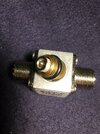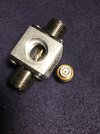I’ve nearing the end of my antenna make over. They are working really good and my last step is connecting an Earth Ground. I’m trying to follow modern theory of keeping the Earth Ground outside so I’m installing an Alpha Delta Surge Protector (TT3G50-HP, 1-500MHz) where the coax enters the building which is also the lowest point of the feedline/coax.
I do not fully understand the gas filled cartridges. I see that extra cartridges are only sold together with a new screw-on cap which suggests the cap is part & parcel to whatever specs apply to the cartridge being sold. For example, the 200w vs 2kw or a cartridge designed for VHF vs below 500MHz. Spark-gap spacing?
So my question is: Does each cartridge have it's own screw-on cap or are all the caps the same? I’ve read owners reporting that the Surge Protector body is the same for all models despite the labeling. I’m only interested in HF so I got the one for 1-500MHz. Can this device drain static charge too? And what to make of the voltage ratings of the different cartridges? There is a large range of voltages available. Then again, why would the cartridge itself have any bearing on the max PO rating if the two feedline connectors are directly connected together? Is this product a gimmick or have I overlooked or mistaken something?
neil, nyc
I do not fully understand the gas filled cartridges. I see that extra cartridges are only sold together with a new screw-on cap which suggests the cap is part & parcel to whatever specs apply to the cartridge being sold. For example, the 200w vs 2kw or a cartridge designed for VHF vs below 500MHz. Spark-gap spacing?
So my question is: Does each cartridge have it's own screw-on cap or are all the caps the same? I’ve read owners reporting that the Surge Protector body is the same for all models despite the labeling. I’m only interested in HF so I got the one for 1-500MHz. Can this device drain static charge too? And what to make of the voltage ratings of the different cartridges? There is a large range of voltages available. Then again, why would the cartridge itself have any bearing on the max PO rating if the two feedline connectors are directly connected together? Is this product a gimmick or have I overlooked or mistaken something?
neil, nyc



